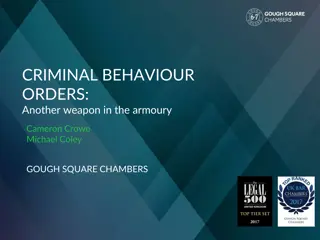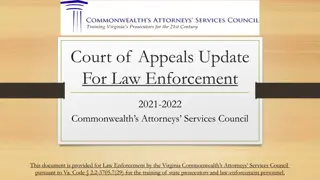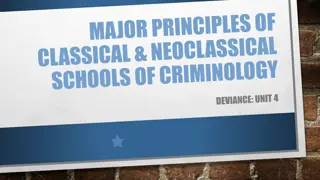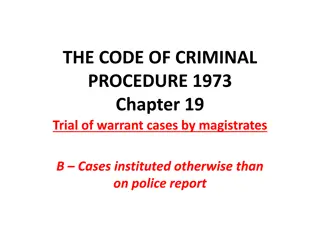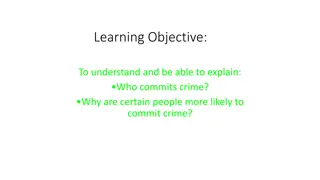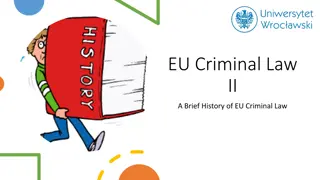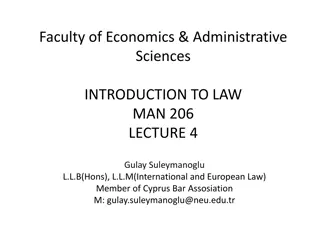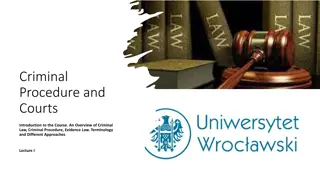Understanding Criminal Law and Procedure: Greenvisor's Case
A case study involving embezzlement by Joe Greenvisor, the chief accountant of Nobreath Corporation, sheds light on criminal acts, duties, intent, and societal perspectives on crime. Despite Greenvisor's charitable intentions, his actions constituted a crime under the law. The elements of criminal acts, duty, violation, and intent are explored in this scenario, highlighting the complexities of criminal behavior in a societal context.
Download Presentation

Please find below an Image/Link to download the presentation.
The content on the website is provided AS IS for your information and personal use only. It may not be sold, licensed, or shared on other websites without obtaining consent from the author. Download presentation by click this link. If you encounter any issues during the download, it is possible that the publisher has removed the file from their server.
E N D
Presentation Transcript
Criminal Law and Procedure CHAPTER 4
Section 4-1 Criminal Law
Whats your verdict? During the recent economic downturn, the Nobreath Corporation, a distributor for various cigarette brands, implemented a new financial control system to help solve its cash-flow problems. A big step towards a solution of those problems was taken when the new system produced reports showing that over the past decade Joe Greenvisor, the company s chief accountant, had embezzled more than $17 million. A subsequent police investigation showed that Greenvisor had given every cent of the embezzled funds to the local lung cancer foundation to help those victimized by smoking. Did Greenvisor commit a crime by his actions?
Crimes and Criminal Behavior Crime punishable offense against society Goal is to protect society, not the victim. 1. Society attempts to identify, arrest, prosecute, and punish the criminal (acting through police and prosecutors). 2. Society decides to determine what action to take against the person who committed the crime (through their chosen representatives). Victim is left with the sole option of suing the perpetrators for civil charges but seldom do b/c few criminals have the ability to pay judgments. Crimes should be carefully defined by statutes or laws which define the behavior it prohibits not interfering with protected individual rights.
3 Elements of Criminal Acts 1. Whether you had a duty imposed by criminal statute to do or not to do a certain thing. 2. Whether you performed an act or omission in violation of that duty. 3. Whether or not you had criminal intent in so doing.
Elements of Criminal Acts (cont.) Duty Everyone has a legally enforceable duty to conform his or her conduct to the law s requirements. In court, prosecutor cites to the judge a statute that prescribes the duty owed in the case at hand. Violation of the Duty The breach of duty (the specific conduct of the defendant that violates the statute) is the criminal act. In a trial must be proven (e.g. testimony of a witness). Criminal Intent The defendant intended to commit the specific act or omission defined as criminal. Intent and motive are 2 separate things: Intent refers strictly to the state of mind that must be present concurrently w/ the alleged criminal act or failure to act. Motive refers to what specifically drives a person to act or refrain from doing so.
Whats your verdict? Answer: Did Greenvisor commit a crime by his actions? Greenvisor owed a duty, defined by state statute, to not take Nobreath Corporation s money. Violation of this duty, the criminal conduct of taking another s property or money by a person to whom it has been entrusted, is embezzlement. This act could be proved with the documentation from the new system and the testimony of investigators. Greenvisor s criminal intent, to wrongfully deprive the company of the money, can be inferred from his conduct. So Greenvisor did commit a crime. His Robin Hood motive does not alter this fact.
Elements of Criminal Acts (cont.) Criminal intent creates 2 issues related to corporations. 1. Can a corporation form criminal intent the way humans can? Yes, if the employees have criminal intent, their employer may be judged to have criminal intent. 2. When a corporate employee commits a crime, can officers be held criminally responsible? Yes, the officer will be held criminally liable under the doctrine of vicarious criminal liability the criminal intent of the employee is used as a substitute for the requirement of criminal intent for an officer.
Elements of Criminal Acts (cont.) Criminal intent also is related to age. Statutes in most states fix the age of criminal liability at 18 (figure ranges from 16 to 19 and in some states minors as young as 7 can be tried as adults if crime is serious (e.g. murder)). Generally, what is a crime for an adult is juvenile delinquency for a minor. Lack of mental capacity to know the difference between right and wrong (e.g. insanity) CAN be a defense. Voluntarily becoming intoxicated or drugged CANNOT. Some minor crimes don t require criminal intent (e.g. traffic offenses) and extreme carelessness can be considered criminal intent.
Checkpoint ? What three elements must be proven at trial before someone can be convicted of a crime? The three elements are duty, violation of the duty, and criminal intent.
Whats your verdict? Murdock and three of his friends from work needed money. Murdock suggested they steal the batteries from the wheelchairs of handicapped persons. The specially engineered batteries could be resold for around a hundred dollars apiece. After one such theft on a late January evening, the disabled victim, although not harmed initially, was left stranded and died of exposure to the cold weather. The gang was apprehended but, under the state criminal code, could only be charged with misdemeanor stealing and involuntary manslaughter, the latter of which often results in acquittal at trial. Could Murdock and his gang be charged with a federal hate crime which would bear a much stiffer penalty?
Classifications of Crimes Crimes can be classified in many ways. One method is to identify against whom or what they are committed. They can also be classified according to the severity of their potential sentences: Felony Crime punishable by confinement for more than a year in a state prison or by a fine of more than $1,000, or both (even death). Murder, kidnapping, arson, rape, robbery, burglary, embezzlement, forgery, theft of large sums, perjury, and hate crimes. Hate crime statute passed in 1969 to cover crimes incited by race, color, religion, and national origin and now includes disability, sexual orientation, gender, or gender identity. These crimes carry stiffer penalties Misdemeanor Less serious crime and is punishable by confinement in a county or city jail for 1 year or less, by a fine of $1,000 or less, or both. Disorderly conduct and speeding. Some states classify lesser misdemeanors as infractions and people convicted of these can only be fined (e.g. littering).
Whats your verdict? Answer: Could Murdock and his gang be charged with a federal hate crime which would bear a much stiffer penalty? Yes, violations of this statute are considered felonies and carry much stiffer penalties than the crimes the Murdock gang otherwise would be charged with. The prosecutor in that situation likely would be glad to utilize this statute to secure a more just penalty for the victim s death.
Checkpoint ? Name the two categories of crimes classified by the severity of their potential sentences. The two categories are misdemeanor and felony.
Whats your verdict? Aware of the huge development costs of translating the new spintronic concepts into actual high-speed microchips for consumer devices, officers from several chip manufacturers held a secret meeting at their trade convention. At the meeting they agreed on a plan to ensure they would recover the development costs and make a large profit by pricing their competing products within 1 percent of the price set by their biggest competitor in the field. They also split the market into geographic regions and agreed to spend 75 percent of each companies promotional budget in their home region. Have the officers and their companies committed any crime?
Business-Related Crimes Like people, businesses are subject to criminal law. These crimes are usually referred to as white-collar crimes don t involve force or violence and do not cause physical injury to people or physical damage to property. Not paying income taxes, stock fraud, using false weighing machines, conspiring to fix prices, making false fire insurance and auto insurance claims, engaging in false advertising, committing bribery, engaging in political corruption, and embezzling. Punishments usually include fines or short prison sentences.
Whats your verdict? Answer: Have the officers and their companies committed any crime? The corporate officers and their corporations were guilty of violating criminal portions of the antitrust laws. Antitrust laws state that competing companies may not cooperate in fixing prices or in dividing sales regions. Antitrust laws require that business firms compete with one another.
Business-Related Crimes (cont.) Larceny The wrongful taking of money or personal property belonging to someone else, with intent to deprive the owner of it. AKA theft Include shoplifting, pick pocketing, and purse snatching. May be a felony or misdemeanor. Classification is determined by the value of the property stolen and other circumstances. Robbery is a variation and it is the taking of property from another s person or immediate presence, against the victim s will, by force or by causing fear. (F) Burglary is another variation and it is entering a building without permission when intending to commit a crime. (F) Receiving Stolen Property Knowingly receiving stolen property with intent to deprive the rightful owner of the property. One who receives this stolen property is known as a fence. False Pretenses One who obtains money or other property by lying about a past or existing fact is guilty of false pretenses. This is a type of fraud.
Business-Related Crimes (cont.) Forgery Falsely making or materially altering a writing to defraud another. Found on checks when one signs another s name without permission or altering the numbers. (F) Bribery Unlawfully offering or giving anything of value to influence performance of an official in the carrying out of his or her public or legal duties. Soliciting or accepting the bribe is also criminal. Bribing nongovernmental parties is called commercial bribery and is unlawful. Computer Crime Larceny definition makes it difficult to prosecute those who steal computer data. In response, the federal and state governments have created the Computer Fraud and Abuse Act specifically targeting computer-related crimes.
Business-Related Crimes (cont.) Extortion Obtaining money or other property from a person by wrongful use of force, fear, or the power of office. Aka - blackmail Conspiracy An agreement between two or more persons to commit a crime. Usually secret and is a crime separate from the crime the parties planned to commit. (M or F) Arson Willful and illegal burning or exploding of a building. Also occurs if you burn your own building to defraud an insurer.
Checkpoint ? Name three types of business-related crimes. The types of business-related crimes identified in the text are price fixing, larceny, receiving stolen property, false pretenses, forgery, bribery, computer crime, extortion, conspiracy, and arson.
Section 4-2 Criminal Procedure
Whats your verdict? During a routine traffic stop of a small truck for speeding, an officer became suspicious of the cargo the truck contained due to a smell coming from inside. When his request to search the truck was refused, the officer radioed for the assistance of a drug dog. Unfortunately, the dog was unavailable. Finally, he ordered the driver to open the cargo area. When the driver did so, the officer found more than a ton of marijuana. At trial, the defense attorney maintained that it was an illegal search and seizure and that the marijuana should not be allowed to be used as evidence. Do you agree? Why or why not?
Rights and Responsibilities One major objective of Constitution was to protect individuals from the powers of the federal government. Authors of the Const. believed it was better for society to give individuals too much liberty than to allow the government too much power. ***Thus, in this country, people suspected or accused of criminal conduct have rights that are not available in many other countries.***
Rights of the Accused Due process requires fundamental fairness in governmental actions: Criminal defendants may not be compelled to testify against themselves. Evidence presented against them cannot be developed by unreasonable searches and seizures by the authorities (probable cause a reasonable ground for belief). The accused criminal has right to be represented by a lawyer and the state will provide one if a person cannot afford to hire one. These substantive rights are the basis for the Miranda warning a common sense statement of vital Constitutional rights. Evidence cannot be used against a defendant at trial if suspect was not properly mirandized. Guilt must be proven beyond a reasonable doubt. Defendants have a constitutional right to a trial by jury.
Whats your verdict? Answer: Do you agree? Why or why not? A police officer s sense of smell was not as keen as a police dog s, else the dogs would not be utilized. Therefore, the search was deemed unreasonable as it lacked probable cause (a reasonable ground for belief) and the marijuana could not be used as evidence.
Responsibility for the Criminal Conduct of Others A person who knowingly aids another in the commission of a crime is also guilty of criminal wrongdoing (e.g. a lookout or one who plans the crime). Corporations can be held vicariously liable for the conduct of their employees and officers of corporations may be criminally liable for their actions as managers.
Checkpoint ? What constitutional rights would you have if you were accused of a crime? The constitutional rights to due process are embedded in the Miranda warning: An accused has the right to remain silent. Anything an accused says can and will be used against the accused in a court of law. The accused has the right to talk to a lawyer for advice before being questioned and to have the lawyer present during questioning. If the accused cannot afford a lawyer, one will be appointed for him or her. If the accused decides to answer questions without a lawyer present, the accused will still have the right to stop answering at any time and consult one if desired. Finally, the accused has the right to have these rights presented to her or him in a form or language that he or she can understand.
Whats your verdict? As a result of eyewitness identification Will and Zack were apprehended for robbing a convenience store in their hometown. As they were being handcuffed, they admitted the crime and told the arresting officers where they could find the loot from the store. The confessions were videotaped by the arresting officers. Later, after receiving legal counsel from a court-appointed public defender, the two claimed that their confessions and the loot recovered as a consequence could not be used as evidence to convict them at trial as they had not been read their Miranda rights before making their admissions. If the videotapes made of the arrest show the allegations of the defendants are correct, can they still be convicted?
Defenses to Criminal Charges In criminal law, a defense is a legal position taken by an accused to defeat the charges against him or her. In court the state must prove that the defendant is guilty beyond a reasonable doubt. Even when the prosecution has conclusive evidence to show such guilt, all too often that evidence cannot be introduced due to procedural defenses and even when there is sufficient admissible evidence, defendants may use substantive defenses to excuse their conduct.
Procedural Defenses Procedural defenses are based on problems with the way evidence is obtained or the way an accused person is arrested, questioned, tried, or punished. Ignorance of the law is NOT a defense.
Whats your verdict? Answer: If the videotapes made of the arrest show the allegations of the defendants are correct, can they still be convicted? If Will and Zack could prove they were not advised of their Miranda rights before confessing, such a violation of their procedural rights under the Constitution would be a valid defense to any attempt by the prosecution to use their confessions or the loot from the store recovered as a consequence as evidence against them. They could, however, still be convicted of the crime by other evidence such as the eyewitness identifications of them.
Substantive Defenses Substantive defenses disprove, justify, or excuse the alleged crime. Most discredit the very substance of the prosecution s case against the defendant. Other substantive defenses are: self-defense, criminal insanity, and immunity. Self-defense is the use of the force that appears to be reasonably necessary to the victim to prevent death, serious bodily harm, rape, or kidnapping. Also extends to members of one s family and household and to others whom one has a legal duty to protect. Only non-deadly force may be used to protect or recover property. Criminal insanity exists when, because of a verifiable mental disease or defect, the accused does not know the difference between right and wrong. If true, there is no criminal intent and therefore no crime. Immunity is freedom from prosecution even when one has committed the crime charged by agreeing to testify about the criminal conduct of several other criminals. A witness who refuses to testify after the grant of immunity is in contempt of court action that hinders the administration of justice and is punishable by imprisonment.
Checkpoint ? Name the two defense categories and give an example of each. The categories are procedural (improper search and seizure of evidence or failure to Mirandize a defendant upon arrest) and substantive (self-defense, criminal insanity, or immunity).
Whats your verdict? To conserve water, a city ordinance prohibited the watering of gardens, flower beds, and yards after the declaration of a drought emergency. Gill was on vacation when the declaration was issued. As soon as she returned from the trip, she began to water her lawn. Gill was caught and cited for violating the ordinance. What is an appropriate penalty for this type of offense?
Punishments for Crimes Punishment any penalty provided by law and imposed by a court. Purpose is not to remedy the wrong but rather to discipline the wrongdoer as well as deter others from similar behavior. It also removes criminals from society and, in some cases, criminals may be rehabilitated during their sentences. Range from fines to imprisonment, and in some cases, death. Courts must consider the Eighth Amendment to not inflict cruel and unusual punishment. An accused person may accept a plea bargain where they plead guilty to a less serious crime in exchange for having a more serious charge dropped.
Whats your verdict? Answer: What is an appropriate penalty for this type of offense? Gill was guilty of an infraction, which did not require criminal intent. Nevertheless, her conduct was illegal so she would probably be fined. Criminal statutes ordinarily set maximum limits for punishment, but allow a judge discretion within those limits.
Checkpoint ? What is the purpose of punishment for a crime? Punishment has several functions: to deter future conduct by the guilty and those who would emulate them, to remove criminals from society, and, in some cases, rehabilitation during the sentences.
Whats your verdict? It was a slow day in Judge Bean s associate circuit court until Miss Langtry was brought in to be arraigned. A widow of advanced but unrevealed age, a deacon at the town s First Church of the Really Repentant, and the owner of a large department store downtown, she was charged with repeatedly parking in the no parking zone in front of her store. At the current time she had 17 outstanding warrants for failure to appear in court to answer the tickets. The prosecutor, who wanted to show that no one is exempt from the law because of their standing in the community, had charged her with a misdemeanor under the state s repeat offender statute. When asked, Miss Langtry pled not guilty to the charges, saying she had been parking in that spot for 38 years. The prosecutor, still on a crusade, requested that bail be set at $10,000 to ensure that she would appear for the trial. Would Judge Bean be justified in granting the defense s request that Miss Langtry be given a R.O.R. in this case?
Pre-trial Criminal Procedure 1ststep in criminal procedure after the report of a crime is an investigation by the proper authorities. Evidence is sent to a prosecutor who may choose to file a formal accusation known as an information against a suspect. In some states and at the federal level, an indictment - a written accusation declaring that there is sufficient evidence to try the identified individual for a specified crime by a grand jury is required for a felony. Grand jury a group of citizens selected to hear, in secret, the evidence of alleged crimes submitted by the prosecutor. 2ndstep is an arrest warrant written court order for the apprehension of an accused will be issued by the court with appropriate jurisdiction. 3rdstep is the individual is arrested or taken into custody for the purpose of answering a criminal charge. Suspect must be advised of constitutional rights and booked, fingerprinted, photographed, give samples of blood and DNA (as allowed by law), and police files are checked to see if there is a prior criminal record.
Pre-trial Criminal Procedure (cont.) 4thstep is arraignment defendant is brought before the court in a proceeding during which the formal charges in the information or in the indictment are read. Defendant enters plea If guilty court will begin to determine punishment. If not guilty the defendant may elect to have a preliminary hearing at which the evidence will be presented to the court to determine if sufficient cause to hold the defendant for trial. At any time, defendant may plead guilty especially if plea bargain was reached. At this time, court will also determine if suspect will stay in jail or be released on bail sum of money or property deposited or pledged to guarantee arrested will appear for preliminary hearing or trial. Determined by judge. Can be refused bail. If can t afford can get a bail bonding agent that charges a fee. Other assets can be pledged should accused jump bail. If can t post bail they stay in jail. If they don t show for trial, bail is forfeited to state and warrant is issued for arrest. Some cases, accused may be released on their own recognizance (R.O.R.) suspect promises to appear as scheduled w/out putting up bail usually given to a reputable citizen w/ substantial assets. For minor offenses a citation can be given where person can appear in court and dispute charge or pay a fine.
Whats your verdict? Answer: Would Judge Bean be justified in granting the defense s request that Miss Langtry be given a R.O.R. in this case? Miss Langtry would easily qualify for Judge Bean s leniency in granting an R.O.R. This usually happens if the accused is a reputable citizen with substantial assets.
Preparations for Trial Both prosecution and defense seek out evidence for their causes as well as both continue investigation. Both may obtain from the courts subpoenas commands an individual to appear and testify or produce documents or other evidence in his or her possession. Failure to appear can warrant a contempt of court. Motions or pleas to the court to order some action or rule pertinent to the case are made by both sides concerning the disclosure, admissibility, or suppression of evidence and other tactical matters.
Procedure at Trial Testimony can be heard by a judge or jury but judge always decides issues of law. Trial jury: Impartial citizens Usually 12 for a criminal trial plus several alternates Selected randomly from various lists Interrogated in writing and orally by both prosecutor and defense attorney. Voir dire preliminary exam of potential jurors to determine their ability to judge ably and impartially the matter to be placed before them. 2 challenges 1) challenge for good cause and 2) preemptory challenge Next attorneys for both sides give an opening statement which briefly outlines each side s case as to what will be proved by the evidence they intend to offer. An cdotas y curiosidades jur dicas | iustop a: enero 2011
Procedure at Trial (cont.) Prosecution presents evidence to prove guilt as defined by the relevant criminal statute and then defense presents their evidence to prove innocence. Evidence includes anything that provides information used to prove or disprove the alleged facts. The side calling a witness conducts the direct examination and when the opposing side questions the witness it is called a cross examination. If the calling side has further questions they can ask again in a redirect exam to counter questions raised on cross and this can be followed by a recross. Expert witnesses can be called to offer their superior knowledge about a subject. Confessions of a Moderate Mormon Feminist: Can I Get A Witness ?!
Procedure at Trial (cont.) Attorneys for each side give closing remarks. Judge instructs jury as to the rules of law and will specify the required elements of the alleged crime that must be shown by the evidence beyond a reasonable doubt in order to convict. Jury retreats to separate room to deliberate and then decides on a verdict. If cannot reach unanimous decision, jury is considered to be a hung jury. If hung can be retried If not guilty set free and can t be retried on same grounds If guilty will have sentencing hearing and can be fined, imprisoned or released on probation restricted status that allows the convicted criminal limited freedom governed by rules laid down by the judge and if violated will be incarcerated. After trial, legal briefs may be submitted to appellate courts and if accepted those courts will either affirm, overturn, or remand the results.
Checkpoint ? What types of challenges can be used by the defense and prosecution to dismiss unwanted potential jurors? The attorneys for either side may dismiss prospective jurors by utilizing their preemptory challenges which bring about an automatic dismissal or their challenges for cause which may or may not be granted by the court depending on the strength of the showing of cause.



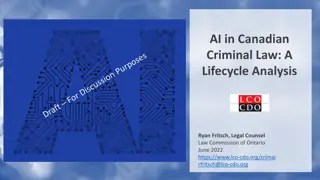
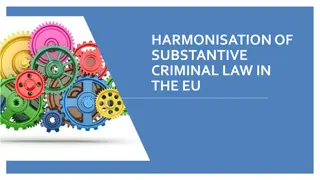
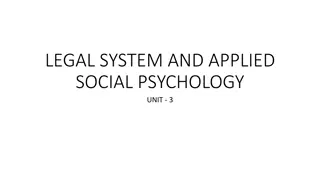
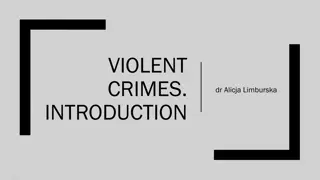
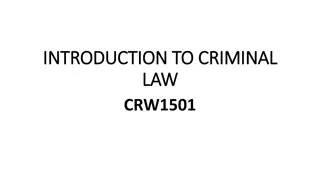
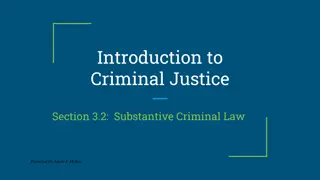
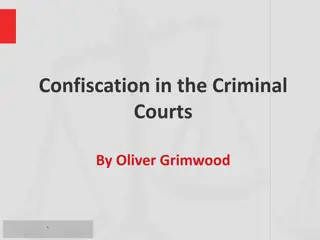
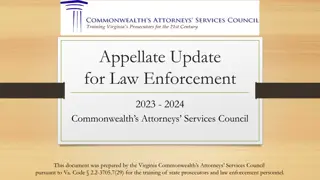
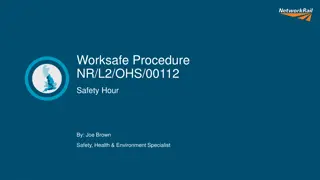
![Briefing on the Criminal Procedure Amendment Bill [B12-2021] to the Portfolio Committee on Justice and Correctional Services](/thumb/157093/briefing-on-the-criminal-procedure-amendment-bill-b12-2021-to-the-portfolio-committee-on-justice-and-correctional-services.jpg)
